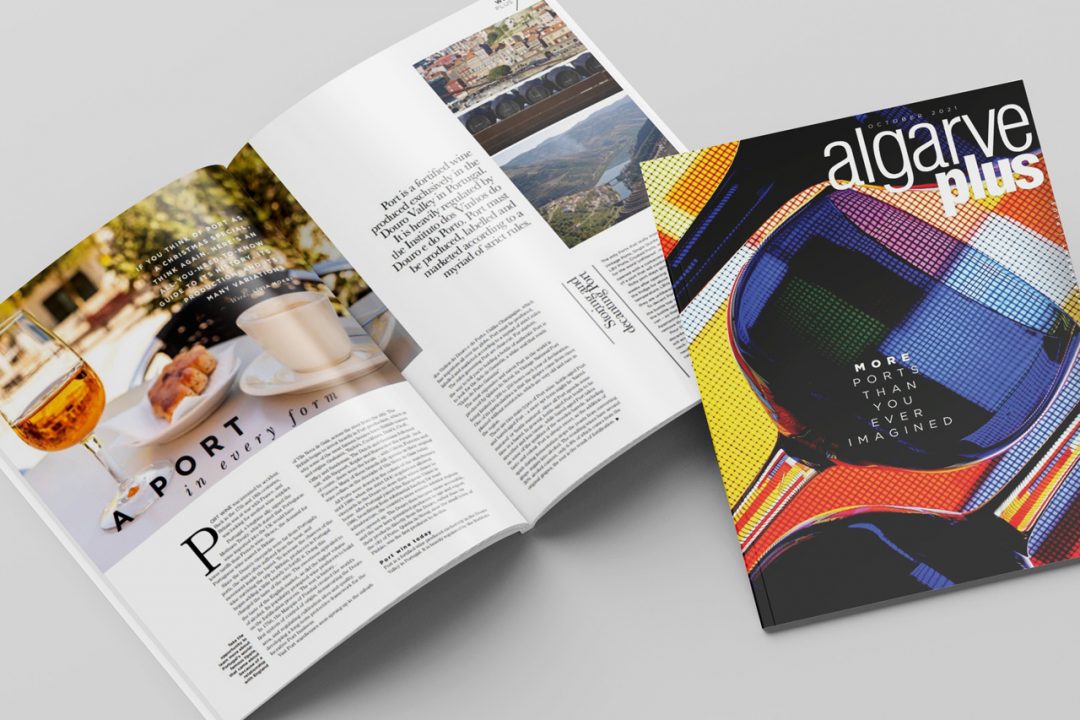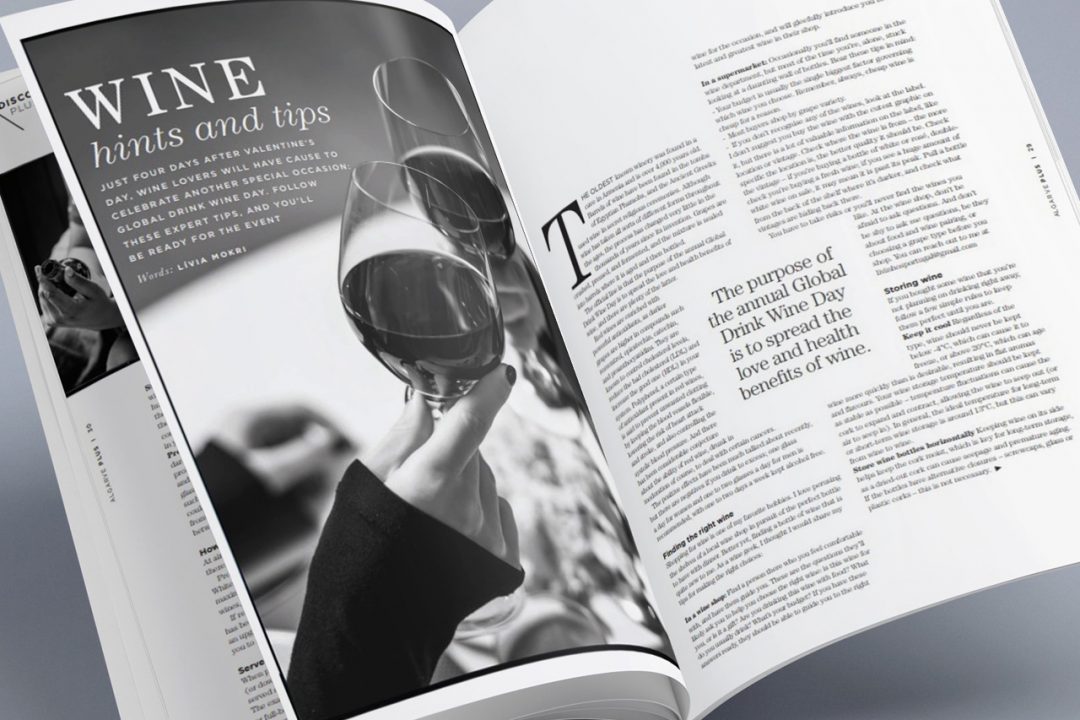A Port in every form – All about the Port wines!
I am happy to share that my new article in the Algarve Plus Magazine has been already published!
If you want to know more about the Port wines, read it here online below.
The magazine is readable online or downloaded for free here.
Enjoy!
Or read here the whole article:
A Port in every form
Did you know that Port wine was invented by accident?
History
The history of Port is one of the oldest datings back to the world of wines.
Back in the 17-18th centuries, Britain was at war with France and was looking for another wine supplier. Portugal, a longtime ally of Britain, signed the Methuen Treaty which stated that Portuguese wine imported in the UK would have lower tariffs than French wine. Lower costs and boycott of French wine meant that demand for Portuguese wine soared in Britain.
Since the Douro’s vineyards were far from Portugal’s ports, the wines often suffered as the heat and movement inside the barrels deteriorated the wines. To increase the chances of the wine surviving the trip to Britain, wine producers in Portugal began adding a little brandy to fortify the wine. By doing this, they actually changed the taste of the wine. Thus, the wine resisted unchanged the voyage at sea and the stop of fermentation with the brandy made the wine more sweet and appropriate to the taste of the English market. The wine was higher in alcohol, sweeter, and more robust. Basically, doing this created the Port wine.
The wine became a huge success in Britain, and soon wine producers actually began making Port on purpose. Port houses established themselves in Vila Nova de Gaia, on the banks of the Douro River opposite Porto city. The wine went down the Douro River in Rabelo boats and aged in the warehouses of Vila Nova de Gaia, as this area has little temperature variation during the year. And, the rest… is already history.
The Port was the world`s first branded wine. The best grapes went into its production, with the economic importance of the Port trade acting as a disincentive to the development of table wines.
In 1756, the Marquis of Pombal created the world`s first system of control of origin, demarcating the Douro area, and regulating cultivation sites and quality, thereby creating a long-term protective framework for the lucrative Port business.
Vast Port warehouses soon began to spring up in the suburb of Vila Nova de Gaia across the river from the city. The British returned to Porto and also invested heavily in port production which is why some of the most famous houses have British names and origins.
Peter Bearsley, whose father founded the Port House Taylor’s, was one of the first Englishmen to travel to the upper Douro. In the mid-1700s, his family was the first to buy vineyards in the region for wine production. Many other wineries carry familiar British names like Grahams, Taylors, Cockburn, Dows, Croft, Offley and Sandeman. The Dutch and German’s would also get involved leading to Niepoort, Kopke and Burmester. And of course, the locals with Cálem, Ferreira and Fonseca being some of the most traditional. Many of these brands still operate their original wine cellars on the riverside of Vila Nova de Gaia today.
All Ports had been stored this way until 1986 when the strict DOC regulations allowed vineyards in the Douro to store their wines closer to home. After Portugal joined the European Union in 1986, benefitted from substantial funding for road infrastructure that opened the country`s more remote interior regions. This way, the Douro became more accessible and gradually began to catch up with the modern world.
The new laws permitted producers to age and export their products directly from the Douro, rather than via the city of Porto. Quinta Do Noval, near the small town of Pinhão, was the first producer to do this.
Douro
The Douro is a huge mountainous area, that spreads out on either side of the River Douro, which river runs from Spain across Portugal to Porto where it flows into the Atlantic Ocean.
In 1756, the Companhia Geral da Agricultura das Vinhas do Alto Douro was created. This body had as its main competencies to limit the region and register the vineyards, classify the wines according to their quality and establish certain wine-growing practices in the region. It was the birth of one of the first demarcated regions in the world.
The Douro is the world`s largest mountain vineyard, it has more than 43,000 hectares under vine, over twice the area of the Napa Valley.
Its grapes are grown on startlingly steep gradients slopes. With extremely low yields per hectare, this is the last major wine region in the world where the grapes are still entirely hand-picked.
Protected by four mountain ranges, the Douro is extremely hot and dry in the summer and tends to be cold and rainy in the winter. Temperatures vary according to elevation, with the warmest vineyards located close to the river, and cooler growing conditions higher up that are better suited for making white wines.
The soil is frequently poor, covered in porous schist or slate that allows the vine roots to penetrate and dig deep in their search for water. These difficult conditions favor the most resilient grape varieties and the creation of the intense flavors that produce fine wine.
Despite these unpropitious conditions, the Douro is now considered one of the world`s great wine regions.
In Douro, the World Bank initiated a vineyard replanting program in the 1990s, and in 2001, the Douro was listed as a UNESCO World Heritage site.
What is Port wine?
Port is a fortified wine produced exclusively in the Douro Valley in Portugal. Port is heavily regulated by the Instituto dos Vinhos do Douro e do Porto. Unlike Champagne, which has impostors all over the globe, Port must be produced, labeled and marketed according to a myriad of strict rules.
The rules governing Port lend it a clear-cut terminology. For starters, the way to tell you’re holding an authentic bottle of Port: look for the Selo de Garantia, a white seal that reads “Vinho do Porto Garantia.”
The most expensive and rarest port in the world is produced by Quinta do Noval. Its Vintage National Port is produced a few times and always in a limited number (200 to 250 boxes).
One of its particularities is the fact that the grapes come from vines planted without rootstocks, very old and rare in the region.
Port is produced by adding brandy to red wine. This ups the alcohol content, but it also preserves more of the natural sugars from the grapes by stopping the fermentation process. So, the region, the sweetness and the higher alcohol content are part of what makes Port special.
The Port is always sweet, as the addition of spirit during fermentation stops the yeasts from converting grape sugars into alcohol. The resulting wines have around 20% alcohol content, only 6 to 8% of which comes from the original grapes; the rest is the result of fortification.
Broadly speaking, there are two main distinctions of Port wine: bottle-aged Port and barrel-aged Port. A more apt term might be “barrel-matured” or “bottle-matured,” since all Port spends some time in a barrel. In general, bottle-aged Port tends to be smoother and less tannic. Barrel-aged Port tends to take on some of the qualities of the wooden barrels, including taste and color. Further, barrel-aged Ports end up more viscous, due to a slight amount of evaporation.
Grape varieties
The Portuguese Douro Valley is undoubtedly one of the most beautiful vineyards in the world. If I were to ask the grapes where the place of Eden where you want to grow would surely choose this region.
The Douro has an unusually high number of grape varieties, all of which are specific to Portugal, with the exception of the Tinta Roriz, the equivalent to Spain`s Tempranillo. The star variety is Touriga Nacional, used in both Port and dry red blends.
The 5 most common local grapes for making Port are Touriga Nacional, Touriga Franca, Tinta Roriz, Tinta Barroca and Tinto Cão.
The steep slopes of the Douro are terraced to stabilize erosion and create the platforms on which vines can be planted. Not only is grape picking done almost entirely by hand, but the cost of labor has also risen substantially over the last generation and yields are low in this dry, hot climate.
How Port is made?
The initial process of making Port wine is fairly similar to making table wine: grapes are grown in the Douro Valley near Porto, then harvested and pressed. The key difference between Port and normal table wine is that of the former, brandy is added to the fermenting grape juice after several days which kills the fermentation process, increases the alcohol levels to around 19-21%, and means there is a lot of residual sugar left over. The Port is then put into large oak casks, after which it will be aged.
Making Port wine is not an easy process as, although the system of terraced vineyards serves to retain heat in the soil during colder evenings, it also means that mechanization is all but impossible and much of the background work has to be done manually. During the grape harvest, which normally begins in the first two weeks of September, they’re crushed in the traditional way – by foot. Once the grapes are harvested, crushed, and strained of debris (stems, seeds, and skins), it has been allowed to ferment until alcohol levels get to around 7%. At this stage, a neutral grape spirit is added to the juices, which spirit has around 75% of alcohol content. This kills the yeast, stops the fermentation process and raises the alcohol levels to 19-22%. The majority of this spirit comes from the Cognac region of France and the La Mancha area of neighboring Spain.
Frequently, the batch of the young Port is pumped into large oak casks, typically for 18 months or so of aging. At the year-and-a-half mark, these young port wines are blended with other batches to find complementary components that will ultimately deliver a delicious wine with well-defined fruit, friendly palate appeal, and overarching balance. The young Port may then be transferred to bottles for further aging or receive additional time in a cask.
During the maturation, the Port house will decide what type of Port the wine will eventually become. Of course, the Port House will know in advance what they want to make. If the grapes are high quality and from a single harvest, for example, they’ll be expecting to make a fine Port, like an LBV, a Vintage Port, or a Colheita.
The Port styles
Port is a sweet wine, full-bodied, and typically lacking in acidity, although lighter-hued Ports have some bright acidity to balance the sweetness. You’ll find aromas of dried fruit, and dark fruits like plum, spice, and wood. It is typically served with or as dessert and the flavors and tannins can vary depending on the type of Port.
There are several categories of Ports, that can usually be broken down further by aging and quality. The terms and their definitions are strictly regulated by the IDVP (Instituto dos Vinhos do Douro e do Porto). You’ll most commonly find Ruby, Tawny and White Port.
But there’s more to Port than just these three styles. Let’s see all of them:
• Ruby Ports: Ruby, Rosé, Reserve Ruby, Late Bottled Vintage (LBV), Crusted, Vintage Port, Single Quinta Vintage Port
• Tawny Ports: Tawny, Reserve Tawny, Tawny Port with Indication of Age, Colheita Port,
• White Port: White Port, Reserve White Port
Whether the harvested grapes end up becoming a Ruby or a Tawny depends on how the wine is initially aged: Ruby Port is initially aged in tanks, usually stainless steel or concrete, while Tawny Port is aged in barrels.
This decision produces two completely different styles of Port that have very different colors, flavors, and aromas. Within those two categories, there are a number of different sub-categories, depending on the quality of the harvest, along with the Port House’s own decisions, the Port may be aged further to produce a higher quality style of Port.
Now, let’s see the Port styles in detail!
Ruby Ports
• Ruby
Ruby is a basic Port wine and is the most widely produced style of Port. It’s usually fairly cheap, and typically around 3-5 years old.
Ruby is usually a blend of different years, and it matures in concrete or stainless steel tanks to prevent oxidation and preserve its deep ruby color. Ruby Port has a rich ruby or claret color, fruity aromas, and fresh fruit flavors. The flavors are simple and nowhere near as developed as an older vintage bottle of Port, but are pleasant nonetheless. Rubies are filtered before bottling and do not generally improve with age, they’re meant to be consumed when they’re bought.
• Rosé
Rosé Port was first made by Croft in 2008.
It comes under the Ruby category, but it’s fermented in a very similar way to a rosé wine: this Port port also made with red wine grapes, the wine barely touches the grape skins, and so it has a very pale color.
It’s normally quite fruity with flavors of red berries like strawberries and raspberries, and also honey and dates.
With its fruit flavors, and this light and sweet nature, it’s been marketed as both a summer aperitif to serve chilled or in a cocktail mix. It’s designed to be an easy drinker that’s served over ice.
• Reserve Ruby
Ruby Reserve Port is similar to Ruby Port in that it’s affordable, bottled as ready-to-drink and blended from several vintages. The difference is that Ruby Reserve Port is blended from higher quality wines and is barrel-aged for about five years.
Reserve Port is made by blending a variety of vintages, all of which normally have an average age of between 5 and 7 years. Like Ruby Port, it’s fruity but it has more complexity than a standard Ruby as it spends more time in the barrel.
• Late Bottled Vintage (LBV)
The Late Bottled Vintages (normally just called an LBV) were created in the 1950s as a reaction to an economic crisis which meant that Port producers were left with unsold vintage wines. They allowed the wine to stay in wood for a longer period of four to six years before bottling and produced a wine with lots of character, but lighter than traditional vintages.
Unlike Ruby Port, LBV Port comes from a specific vintage and will have a year shown somewhere on the label. Late Bottled Vintage Port is ready to drink as soon as you purchase it.
You’ll come across both filtered and unfiltered LBVs. Sometimes the wine label will say, but often you can tell by the cork: plastic-topped stoppers usually mean a filtered LBV.
An unfiltered LBV will need decanting. Most LBVs are ready to drink straight away, but an unfiltered LBV can improve with bottle aging if you want to store it. Filtered LBVs generally don’t improve with bottle aging.
Unfiltered LBVs labeled ‘Envelhecido em Garrafa’ (means aged in bottle) have also matured in the bottle for a minimum of three years.
Like vintage Ports, LBVs can be quite fruity with hints of plum, blackberries and vanilla on the nose.
• Vintage Port
Vintage Port is at the top of Ruby’s hierarchy and is some of the most exclusive wines you can find. The word ‘vintage’ is a specific term that refers to an exceptional harvest year of grapes. It means that both the quantity and quality of the grapes have aligned to an extraordinary standard. The grapes have to achieve such high standards of quality that a vintage declaration is rarely made more than three times in a decade. If a house decides that its wine is of a quality sufficient for a vintage, samples will be sent to the IVDP (Instituto dos Vinhos do Douro e Porto) for approval. In good years, almost all the houses will declare their wines.
This is the only Port that matures in the bottle, meaning that these bottles go straight into the cellar for about 20 years. That’s because Vintage Port only spends about two years in the barrel before its bottled, meaning it has a lot of maturing to do by the time it hits the shelf. One thing to appreciate about Vintage Port is its rarity — most houses won’t even declare a vintage unless it was an excellent year. While many producers will have a Late Bottled Vintage Port for every year, Vintage Ports may only get bottled thrice in a decade.
The grapes usually come from different vineyards, but they always come from the same year.
Vintage Port is always unfiltered and can continue to mature for another 20 years or even longer once bottled. This, of course, means that it will need decanting and a little time to breathe before it’s ready to be consumed.
Vintage Ports are the most expensive and sought-after style. These wines can age up to 40 to 50 years before they are ready to be fully enjoyed.
These wines form sediment when they are stored and the bottles should be kept laying down. The bottle should be turned upright one day before drinking, decanted two hours before serving and drunk within two days of being opened. They are the best consumed at 17 °C and work wonderfully when served with dark chocolate or with good Stilton cheese. However, I think they are at their best on their own.
• Single Quinta Vintage Port
Single Quinta Vintage Port (SQVP) is a specific type of vintage Port, and it signifies a Vintage Port that’s made from the grapes of a single estate (Quinta). It’s not commonly produced, and it can be quite hard to get one.
Quinta is the word for estate and refers to the specific vineyard of origin. Single Quinta Vintage Port (SQVP), is a wine from a single property during one exceptional year (vintage). These are some of the most exclusive to come across and sometimes most sought after for collectors. However, that might not mean they are the absolute best. In a vintage year, the Port houses will blend the best grapes from a variety of Quintas to produce their vintage port. An SQVP is the wine from one estate and although a vintage, may not represent the absolute highest quality of grapes. Usually, the bigger Port houses will not produce an SQVP during a vintage year, as they’ll want their best grapes to support their Vintage production and not SQVP.
Single Quinta Vintage Port is made in the same way as Vintage Port and is usually approachable after ten years or so.
Nevertheless, it can be exceptionally good and close to Vintage Port in quality and will last for about twenty-five years. And like Vintage Port, it needs to be decanted off the sediment that will have formed in the bottle.
Tawny Ports
· Tawny
Tawny Ports start their lives as Ruby Ports but are made from wine aged in wooden barrels. They spend 10 to 40 years in the barrel, rounding out their flavors, oxidizing slightly and taking on a nice mahogany hue from the wood. The wood contact allows both evaporation and oxidation, which changes the color of the wines, they lose their deep red color as they age, turning from deep ruby to amber-orange, before reaching their typical golden-brown color. They appear rusty or tawny, rather than bright red.
Unlike Rubies, the Tawnies will typically be aged in smaller wooden casks of between 500-600 liters. The smaller casks are used to allow gentle exposure to oxygen. There are only four ages that a Tawny Port can bear: 10, 20, 30 and 40 years. Their long stint in the barrel allows Tawny Ports to lose their fruitiness as they take on a silky mouthfeel, rich, complex flavors and aromas running the gamut from nutty or caramel to chocolate or leathery.
The greater the age, the more nuanced the flavors. It is said that a 20-year Tawny Port provides the best return. At this stage, the tannins begin softening up, allowing the flavors to really come forward.
These are the port wines that the Portuguese most like to drink themselves.
As these wines have been oxidized already, once opened, they can be kept for much longer than Ruby ports and are sold with stoppers rather than simple corks. Some 40-year-old Tawny will keep up its flavors to a year after opening. The inherent sweetness and distinctive tastes and smells of Tawny Ports make them ideal to finish off a rich meal, which is one of the reasons they have become so associated with Christmas.
• Reserve Tawny
This indicates a Tawny that has spent around 7 years in oak.
At the bottom of the scale is this typical Tawny Port and it is labeled without an indication of age. This is a blend of wines that have spent around three years in oak barrels.
The Reserve Tawny Port is similar to a Reserve Ruby, but the former is more complex as they’re blended with aged and higher quality wines.
• Tawny Port with Indication of Age
A Tawny Port with Indication of Age is a Tawny that’s 10, 20, 30, or over 40 years old.
But age doesn’t mean a single vintage: a Tawny is usually a blend of several different wines, and usually, those wines come from several different years. The Tawny Ports will have the age of the blend on the bottle, but here it’s an average of the wines in the bottles, and not completely made up of a specific age of the wine. For example, a 10-year tawny can be made of a blend of 5 and 20 years aged old wines.
These Tawnies are much lighter in color than Ruby or bottle-matured red Ports, it takes on a brown or amber hue with age and has a nuttier, more delicate taste which response well to being served chilled.
• Colheita Port
Colheita is the Portuguese word for harvest, and it’s a type of Tawny Port where all of the grapes come from a single year. By law, a Colheita Port must remain in a cask for seven years prior to bottling, but many will spend a lot longer in wood than that.
On its label, there are two dates: the vintage year and the year it was bottled. The bigger the gap between the two, the more interesting those flavors will be.
Originally, Colheitas were produced by the Portuguese port houses in an attempt to create an exclusive Tawny to rival the Vintage Rubies. With their success, came replication and now many of the other port houses produce their own Colheita.
These wines do not require decanting.
White Ports
- White Port
As the name implies, white port is made from a variety of white grapes. The most commonly used white grapes are Códega, Malvasia Fina, Gouveio, Rabigato, and Viosinho.
It usually has the sweetness of a Ruby Port without retaining as much of the body. It’s usually much lighter and fresher, and often with fruit notes like apricot or peach.
There are actually several different styles of White Port, which indicate sweetness: Extra Seco (very dry), Seco (dry), Doce (sweet), and Lagrima (very sweet). The word Lagrima means ‘tears’ as it’s said the wine should look like tears as it runs down the side of the glass it’s poured in.
The process for making White Port is the same as a red Port. White Port is normally not aged for very long and is normally broken down by sweetness.
Although there are aged White Ports, the majority are meant to be drunk as young and range from crisp dry wines, perfect to serve with tonic, ice and lemon or as a chilled accompaniment to seafood, or the sweeter versions, which are excellent with desserts. It’s often used in Portugal in a signature cocktail, called Port Tonic.
- Reserve White Port
White Port is typically bottled young, but it is possible to find aged White Ports as well. The aging categories are very similar to Tawny Port, so you’ll find also Reserve, 10, 20, 30, and 40-year-old White Ports.
How to store Port?
Most Port is designed to be drunk straight away rather than stored. The only Ports that really improve with aging are Vintage Ports, Single Quinta Vintage Ports, Unfiltered LBV Ports, Crusted Ports, and certain Colheitas. Again, look for the word ‘unfiltered’ or a cork that needs to be opened with a corkscrew. Both of these are indicators of a Port that’ll continue to mature in the bottle.
If you do decide to store Port, keep it in a cool and dark environment and store it on its side. This ensures that the cork remains damp and a tight fit in the bottleneck. A cellar is an ideal location, but really you’re looking for somewhere that’s not going to get hot and won’t have fluctuations in temperature. Store the bottles in the dark, undisturbed at a steady temperature (approx 13-15 ºC), and humidity (approx 70-75 %). Port stored in this way will mature gently at its own unforced pace.
As mentioned above, Ruby Port stays good for about three to four weeks after opening. Tawny Ports can be kept in the fridge for about a month, or two weeks at room temperature. LBVs can last for a week, maybe two if they are unfiltered.
How to decant Port?
Some Port, particularly Vintage Port, needs decanting. You can usually tell if a Port needs decanting if it has the word “unfiltered” on the bottle or, failing that, by the cork, as I mentioned before. The plastic topped easy-to-open corks usually signify a Port wine that has already been filtered, while unfiltered Ports will need to be opened with a corkscrew.
Remove any wax or capsule from the bottle top so that the cork is accessible. Stand the bottle upright for 24 hours in advance, 48 hours if you can, so that the sediment sinks to the bottom of the bottle. Approximately an hour before serving, carefully remove the cork.
Pour the Port slowly and steadily into a clean decanter over an upturned candle or lamp. The light will enable you to see any sediment approaching the neck of the bottle. When the sediment reaches the neck of the bottle, stop pouring. You should have only 1-2 centimeters of Port with sediment left in the bottle.
An alternative method is to decant the Port through a sieve or filter to remove sediment, especially useful if the cork has crumbled into the bottle.
How to serve Port?
Port wine is normally served in servings of around 85 ml (3 oz) in a Port wine glass, which is narrower than a normal wine glass.
Rosé Port should be served ice cold, White Port cold (8-10 °C), Tawny Port cool (10-14 °C), and Ruby Port at cellar temperature (14-18 °C).
Do not forget! The Port that has been decanted will oxidize quickly and will need to be drunk within a day or two. Tawny Ports and cheaper Ruby Ports will last longer and can keep for up to a month at a time.
Food Pairings
Exact pairings will vary depending on the variety of Ports.
Tawny Port pairs well with sweet desserts (such as crème brûlée or apple tart), aperitif or starters (salty dishes and antipasti like oysters, hard cheeses, patés, or cured meats), and also fatty, salty dishes.
When pairing Ruby Ports, seek contrast! The sweet, fruity Ruby-style Port goes well with strong cheeses (such as Stilton), dark chocolates and spicy, hot dishes.
The White Port is typically drunk as an aperitif, but it can be also used as a replacement for Gin in any cocktails, especially the ‘Port-Tonic’. Ideal pairings with olives and roasted salted almonds.
Where to buy Port wines in Algarve?
In person, you can buy any Port wines in the bigger supermarket chains and local wine shops in the Algarve.
Or, you can also order your wines online at the Garrafeira Soares website which chain also has shops in many major cities in the Algarve. The wines can be ordered to your home or picked up at one of their wine shops.
https://www.garrafeirasoares.pt/en/
The price of the wine depends on the producer, the re-seller, the style and the age of the Port wines. It can range from 4 Euros to the starry sky.
If you have never drunk Port wine yet, start with a Ruby Port, which is typically a blend of young Ports that have been barrel-aged for about three to five years. Ruby Port is often filtered, meaning it’s ready to drink as soon as it’s bottled—no decanting required.
Enjoy the Port wines like you enjoy any other glass of wine, noting its color, aroma and the balance of its tannins, acidity and flavors. Try different styles, different producers, and take notes.
Develop your own taste for Port wines!
Cheers!






No Comments Found